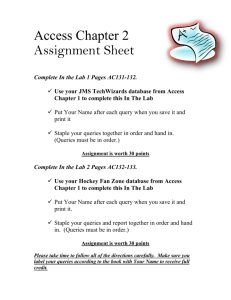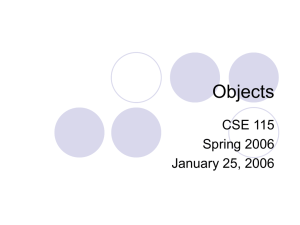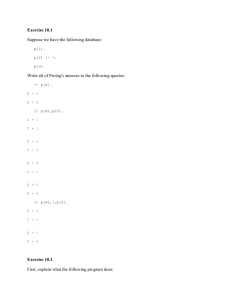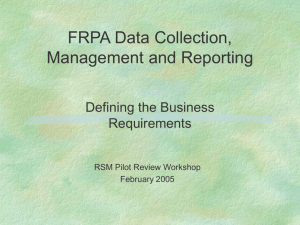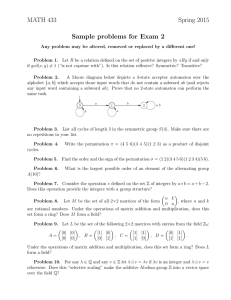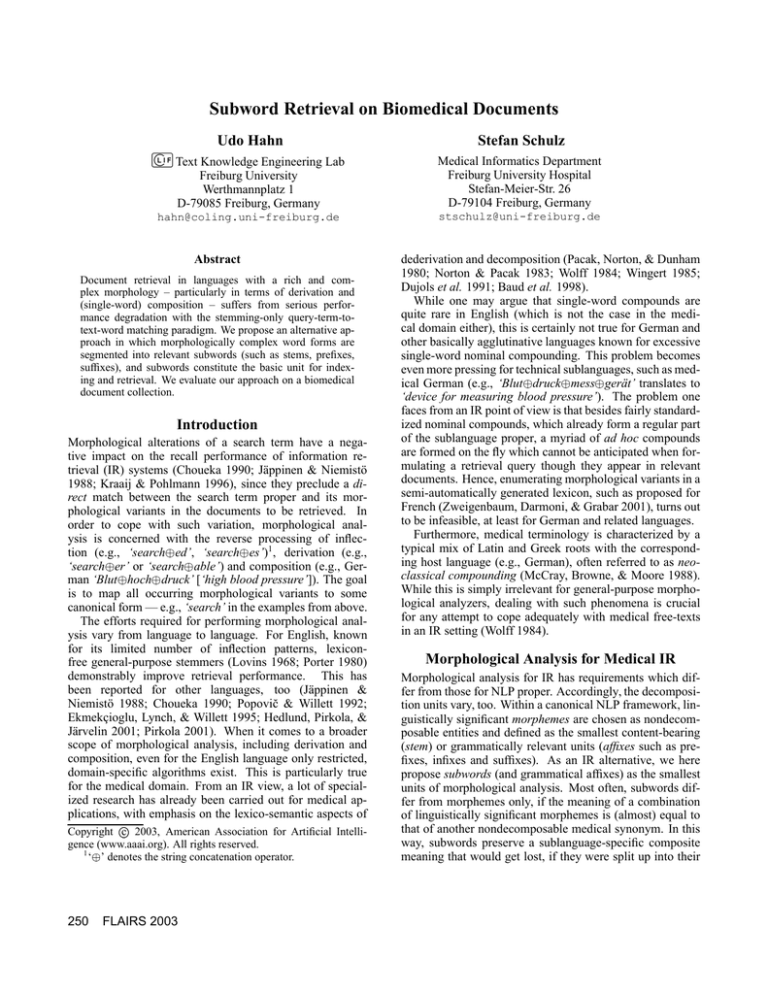
Subword Retrieval on Biomedical Documents
Udo Hahn
Text Knowledge Engineering Lab
Freiburg University
Werthmannplatz 1
D-79085 Freiburg, Germany
hahn@coling.uni-freiburg.de
Abstract
Document retrieval in languages with a rich and complex morphology – particularly in terms of derivation and
(single-word) composition – suffers from serious performance degradation with the stemming-only query-term-totext-word matching paradigm. We propose an alternative approach in which morphologically complex word forms are
segmented into relevant subwords (such as stems, prefixes,
suffixes), and subwords constitute the basic unit for indexing and retrieval. We evaluate our approach on a biomedical
document collection.
Introduction
Morphological alterations of a search term have a negative impact on the recall performance of information retrieval (IR) systems (Choueka 1990; Jäppinen & Niemistö
1988; Kraaij & Pohlmann 1996), since they preclude a direct match between the search term proper and its morphological variants in the documents to be retrieved. In
order to cope with such variation, morphological analysis is concerned with the reverse processing of inflection (e.g., ‘search ed’, ‘search es’)1, derivation (e.g.,
‘search er’ or ‘search able’) and composition (e.g., German ‘Blut hoch druck’ [‘high blood pressure’]). The goal
is to map all occurring morphological variants to some
canonical form — e.g., ‘search’ in the examples from above.
The efforts required for performing morphological analysis vary from language to language. For English, known
for its limited number of inflection patterns, lexiconfree general-purpose stemmers (Lovins 1968; Porter 1980)
demonstrably improve retrieval performance. This has
been reported for other languages, too (Jäppinen &
Niemistö 1988; Choueka 1990; Popovic̆ & Willett 1992;
Ekmekçioglu, Lynch, & Willett 1995; Hedlund, Pirkola, &
Järvelin 2001; Pirkola 2001). When it comes to a broader
scope of morphological analysis, including derivation and
composition, even for the English language only restricted,
domain-specific algorithms exist. This is particularly true
for the medical domain. From an IR view, a lot of specialized research has already been carried out for medical applications, with emphasis on the lexico-semantic aspects of
Copyright c 2003, American Association for Artificial Intelligence (www.aaai.org). All rights reserved.
1
‘ ’ denotes the string concatenation operator.
250
FLAIRS 2003
Stefan Schulz
Medical Informatics Department
Freiburg University Hospital
Stefan-Meier-Str. 26
D-79104 Freiburg, Germany
stschulz@uni-freiburg.de
dederivation and decomposition (Pacak, Norton, & Dunham
1980; Norton & Pacak 1983; Wolff 1984; Wingert 1985;
Dujols et al. 1991; Baud et al. 1998).
While one may argue that single-word compounds are
quite rare in English (which is not the case in the medical domain either), this is certainly not true for German and
other basically agglutinative languages known for excessive
single-word nominal compounding. This problem becomes
even more pressing for technical sublanguages, such as medical German (e.g., ‘Blut druck mess gerät’ translates to
‘device for measuring blood pressure’). The problem one
faces from an IR point of view is that besides fairly standardized nominal compounds, which already form a regular part
of the sublanguage proper, a myriad of ad hoc compounds
are formed on the fly which cannot be anticipated when formulating a retrieval query though they appear in relevant
documents. Hence, enumerating morphological variants in a
semi-automatically generated lexicon, such as proposed for
French (Zweigenbaum, Darmoni, & Grabar 2001), turns out
to be infeasible, at least for German and related languages.
Furthermore, medical terminology is characterized by a
typical mix of Latin and Greek roots with the corresponding host language (e.g., German), often referred to as neoclassical compounding (McCray, Browne, & Moore 1988).
While this is simply irrelevant for general-purpose morphological analyzers, dealing with such phenomena is crucial
for any attempt to cope adequately with medical free-texts
in an IR setting (Wolff 1984).
Morphological Analysis for Medical IR
Morphological analysis for IR has requirements which differ from those for NLP proper. Accordingly, the decomposition units vary, too. Within a canonical NLP framework, linguistically significant morphemes are chosen as nondecomposable entities and defined as the smallest content-bearing
(stem) or grammatically relevant units (affixes such as prefixes, infixes and suffixes). As an IR alternative, we here
propose subwords (and grammatical affixes) as the smallest
units of morphological analysis. Most often, subwords differ from morphemes only, if the meaning of a combination
of linguistically significant morphemes is (almost) equal to
that of another nondecomposable medical synonym. In this
way, subwords preserve a sublanguage-specific composite
meaning that would get lost, if they were split up into their
constituent morpheme parts. However, we also measure the
of different subword lengths on their retrieval pereffects
formance and then choose the optimal, though linguistically
not necessarily natural one.
Hence, we trade linguistic atomicity against either medical plausibility or system feedback, and claim that the latter are beneficial for boosting the system’s retrieval performance. For instance, a medically justified minimal segmentation of ‘diaphysis’ into ‘diaphys is’ will be preferred
over a linguistically motivated one (‘dia phys is’), because the first can be mapped to the quasi-synonym stem
‘shaft’. Such a mapping would not be possible with the
overly unspecific morphemes ‘dia’ and ‘phys’, which occur in numerous other contexts as well (e.g.‘dia gnos is’,
‘phys io logy’). Hence, a decrease of the precision of
the retrieval system would be highly likely due to oversegmentation of semantically opaque compounds. Accordingly, we distinguish the following decomposition classes:
Subwords like ‘gastr’, ‘hepat’, ‘nier’, ‘leuk’, ‘diaphys’,
are the primary content carriers in a word. They can be
prefixed, linked by infixes, and suffixed. As a particularity
of the German medical language, proper names may appear
as part of complex nouns (e.g., ‘Parkinson verdacht’ [‘suspicion of Parkinson’s disease’]) and are therefore included
in this category.
Short words, with four characters or less, like ‘ion’,
‘gene’, ‘ovum’ , are classified separately applying stricter
grammatical rules (e.g., they cannot be composed at all).
Their stems (e.g., ‘gen’ or ‘ov’) are not included in the
dictionary in order to prevent false ambiguities. The price
one has to pay for this decision is the inclusion of derived
and composed forms in the subword dictionary (e.g., ‘anion’,‘genet’,‘ovul’).
Acronyms such as ‘AIDS’, ‘ECG’, and abbreviations (e.g., ‘chron.’ [for ‘chronical’], ‘diabet.’ [for ‘diabetical’]) are nondecomposable entities in morphological
terms and do not undergo any further morphological variation, e.g., by suffixing.
Prefixes like ‘a-’, ‘de-’, ‘in-’, ‘ent-’, ‘ver-’, ‘anti-’, precede a subword.
Infixes (e.g., ‘-o-’ in “gastr o intestinal”, or ‘-s-’
in ‘Sektion s bericht’ [‘autopsy report’]) are used as a
(phonologically motivated) ‘glue’ between morphemes, typically as a link between subwords.
Derivational suffixes such as ‘-io-’, ‘-ion-’, ‘-ie-’, ‘-ung’, ‘-itis-’, ‘-tomie-’, usually follow a subword.
Inflectional suffixes like ‘-e’, ‘-en’, ‘-s’, ‘-idis’, ‘-ae’, ‘oris’, appear at the very end of a composite word form
following the subwords or derivational suffixes.
Prior to segmentation a language-specific orthographic
normalization step is performed. It maps German umlauts
‘ä’, ‘ö’, and ‘ü’ to ‘ae’, ‘oe’, and ‘ue’, respectively, translates ‘ca’ to ‘ka’, etc. The morphological segmentation procedure for German in May 2002 incorporates a subword dictionary composed of 4,648 subwords, 344 proper names,
and an affix list composed of 117 prefixes, 8 infixes and 120
(derivational and inflectional) suffixes, making up 5,237 entries in total. 186 stop words are not used for segmenta-
tion. In terms of domain coverage the subword dictionary
is adapted to the terminology of clinical medicine, including
scientific terms, clinicians’ jargon and popular expressions.
The subword dictionary is still in an experimental stage and
needs on-going maintenance. Subword entries that are considered strict synonyms are assigned a shared identifier. This
thesaurus-style extension is particularly directed at foreignlanguage (mostly Greek or Latin) translates of source language terms, e.g., German ‘nier’ E Q Latin ‘ren’ (E Q English
‘kidney’), as well as at stem variants.
The morphological analyzer implements a word model
using regular expressions and processes input strings following the principle of ‘longest match’ (both from the left and
from the right). It performs backtracking whenever recognition remains incomplete. If a complete recognition cannot
be achieved, the incomplete segmentation results, nevertheless, are considered for indexing. In case the recognition
procedure yields alternative complete segmentations for an
input word, they are ranked according to preference criteria, such as the minimal number of stems per word, minimal
number of consecutive affixes, and semantic weight.2
Experimental Setting
As document collection for our experiments we chose the
CD-ROM edition of MSD, a German-language handbook of
clinical medicine (MSD 1993). It contains 5,517 handbookstyle articles (about 2.4 million text tokens) on a broad range
of clinical topics using biomedical terminology.
In our retrieval experiments we tried to cover a wide range
of topics from clinical medicine. Due to the importance of
searching health-related contents both for medical professionals and the general public we collected two sets of user
queries, viz. expert queries and layman queries.
Expert Queries. A large collection of multiple choice
questions from the nationally standardized year 5 examination questionnaire for medical students in Germany constituted the basis of this query set. Out of a total of 580
questions we selected 210 ones explicitly addressing clinical issues (in conformance with the range of topics covered
by MSD). We then asked 63 students (between the 3rd and
5th study year) from our university’s Medical School during regular classroom hours to formulate free-form natural
language queries in order to retrieve documents that would
help in answering these questions, assuming an ideal search
engine. Acronyms and abbreviations were allowed, but the
length of each query was restricted to a maximum of ten
terms. Each student was assigned ten topics at random, so
we ended up with 630 queries from which 25 were randomly
chosen for further consideration (the set contained no duplicate queries).
Layman Queries.
The operators of a Germanlanguage medical search engine (http://www.dr-antonius.de/) provided us with a set of 38,600 logged
queries. A random sample (
=400) was classified by a med2
A semantic weight =2 is assigned to all subwords and
some semantically important suffixes, such as ‘-tomie’ [‘-tomy’] or
‘-itis’; =1 is assigned to prefixes and derivational suffixes; =0
holds for inflectional suffixes and infixes.
FLAIRS 2003
251
ical expert whether they contained medical jargon or the
of laymen. Only those queries which were univowording
cally classified as layman queries (through the use of nontechnical terminology) ended up in a subset of 125 queries
from which 27 were randomly chosen for our study.
The judgments for identifying relevant documents in the
whole test collection (5,517 documents) for each of the 25
expert and 27 layman queries were carried out by three medical experts (none of them was involved in the system development). Given such a time-consuming task, we investigated only a small number of user queries in our experiments. This also elucidates why we did not address interrater reliability. The queries and the relevance judgments
were hidden from the developers of the subword dictionary.
For unbiased evaluation of our approach, we used a homegrown search engine (implemented in the P YTHON script
language). It crawls text/HTML files, produces an inverted
file index, and assigns salience weights to terms and documents based on a simple tf-idf metric. Retrieval relies on the
vector space model (Salton 1989), with the cosine measure
expressing the similarity between a query and a document.
The search engine produces a ranked output of documents.
We also incorporate proximity data, since this information becomes particularly important in the segmentation of complex word forms. So a distinction must be
made between a document containing ‘append ectomy’ and
‘thyroid itis’ and another one containing ‘append ic itis’
and ‘thyroid ectomy’. Our proximity criterion assigns a
higher ranking to adjacent and a lower one to distant search
terms. This is achieved by an adjacency offset, , which is
added
to the cosine measure
ofeach
For a query
document.
consisting of terms,
, the minimal
dis!
), is retance between a pair of terms in a document, (
:
calculated as follows:
ferred to by "$#&%&' ( . The offset is then
)*,+
.0/1.325476
9:
8
;=<
9?
> <
;=<
@ AB
4
%1' (
@
(1)
We distinguished four different conditions for the retrieval
experiments, viz. plain token match, trigram match, plain
subword match, and subword match incorporating synonym
expansion (Table 1 summarizes the different test scenarios
considered.):
Plain Token Match (WS). A direct match between text
tokens in a document and those in a query is tried. No normalizing term processing (stemming, etc.) is done prior to
indexing or evaluating the query. The search was run on
an index covering the entire document collection (182,306
index terms). This scenario serves as the baseline for determining the benefits of our approach. 3
Trigram Match (TG). As an alternative lexicon-free indexing approach (which is more robust relative to misspellings and suffix variations) we considered each document and each query indexed by all of their substrings with
character length ‘3’.
3
This is a reasonable baseline, since up to now there is no
general-purpose, broad-coverage morphological analyzer for German available, which forms part of a standard retrieval engine.
252
FLAIRS 2003
Subword Match (SU). We created an index building
upon the principles of the subword approach. Morphological segmentation yielded a shrunk index, with 39,315 index
terms remaining. This equals a reduction rate of 78% compared with the number of text types in the collection.4
Synonym-Enhanced Subword Match (SY). Instead of
subwords, synonym class identifiers which stand for several
subwords are used as index terms.
The following add-ons were supplied for further
parametrizing the retrieval process:
Orthographic Normalization (O). In a preprocessing
step, orthographic normalization rules were applied to
queries and documents.
Adjacency Boost (A). Information about the position of
each index term in the document (using the adjacency offset,
) is made available for the search process.
Name of
Test
WS
WSA
WSO
WSAO
TG
SU
SY
Index
Made of
Words
Words
Words
Words
Trigrams
Subwords
Synonym
Class Ids
Orthographic
Normalization
+
+
+
+
Adjacency
Boost
+
+
+
+
Table 1: Different Test Scenarios
Experimental Results
The assessment of the experimental results is based on the
aggregation of all 52 selected queries on the one hand, and
on a separate analysis of expert vs. layman queries, on the
other hand. In particular, we calculated the average interpolated precision values at fixed recall levels (we chose a
continuous increment of 10%) based on the consideration of
the top 200 documents retrieved. Additionally, we provide
the average of the precision values at all eleven fixed recall
levels (11pt recall), and the average of the precision values
at the recall levels of 20%, 50%, and 80% (3pt recall).
We here discuss the results from the analysis of the complete query set the data of which is given in Table 2. For
our baseline (WS), the direct match between query terms
and document terms, precision is already poor at low recall
points ( CEDGF$HJI ), ranging in an interval from 53.3% to
31.9%. At high recall points (CLKNMHJI ), precision drops
from 19.1% to 3.7%. When we take term proximity (adjacency) into account (WSA), we observe a small though statistically insignificant increase in precision at all recall points,
1.6% on average. Orthographic normalization only (WSO),
however, caused, interestingly, a marginal decrease of precision, 0.6% on average. When both parameters, orthographic
4
The data for the English version, 50,934 text types with 24,539
index entries remaining after segmentation, indicates a significantly lower reduction rate of 52%. The size of the English subword dictionary (only 300 entries less than the German one) does
not explain the data. Rather this finding reveals that the English
corpus has fewer single-word compounds than the German one.
Rec.
O
(%)
0
10
20
30
40
50
60
70
80
90
100
3pt
avr
11pt
avr
53.3
46.6
37.4
31.9
28.9
26.6
24.5
19.1
14.4
9.5
3.7
26.1
56.1
50.7
40.1
33.2
30.4
28.6
25.9
19.9
15.2
9.8
3.9
28.0
Precision (%)
WSO WS
TG
AO
53.3
60.0 54.8
46.1
55.8 45.4
37.0
42.1 32.1
31.5
34.5 26.3
28.0
30.3 20.2
26.0
28.7 15.9
23.5
25.0
9.3
17.9
18.7
6.5
13.0
14.0
4.4
9.6
9.9
0.8
3.8
4.0
0.64
25.3
28.3 17.4
26.9
28.5
26.3
WS
WSA
29.4
19.6
SU
SU
SY
56.8
53.2
44.7
34.8
29.3
26.5
22.0
13.5
11.6
4.4
4.0
27.6
Precision (%)
WSO WS
TG
AO
50.3
60.8 56.6
44.6
59.8 48.7
38.1
48.6 35.8
31.0
37.3 30.6
24.3
29.0 21.6
20.9
26.5 19.7
16.9
20.1 10.9
9.3
11.1
7.7
7.1
9.1
6.5
4.1
4.7
1.7
4.0
4.4
1.3
22.1
28.1 20.7
67.3
60.3
50.8
46.5
37.3
34.2
24.7
19.9
14.2
9.2
8.3
33.1
64.7
60.3
50.3
45.7
32.0
28.3
20.3
15.7
10.3
8.3
7.6
29.7
27.3
22.8
33.9
31.2
SY
74.0
62.3
52.3
45.8
39.2
35.6
29.7
24.4
19.6
14.7
10.0
35.8
73.2
61.0
51.7
45.1
36.5
32.7
28.1
22.7
18.1
14.6
10.2
34.1
37.0
35.8
Rec.
(%)
0
10
20
30
40
50
60
70
80
90
100
3pt
avr
11pt
avr
Table 2: Precision/Recall Table for All Queries
normalization and adjacency, are combined (WSAO), they
produce an increase of precision at nine from eleven recall
points, 2.5% on average compared with WS. None of these
differences are statistically significant when the two-tailed
Wilcoxon test is applied at all eleven recall levels.
Trigram indexing (TG) yields the poorest results of all
methodologies being tested. It is comparable to WS at low
recall levels ( CPDQF$HRI ), but at high ones its precision decreases almost dramatically. Unless very high rates of misspellings are to be expected (this explains the favorable results for trigram indexing in (Franz et al. 2000)) one cannot
really recommend this method.
The subword approach (SU) clearly outperforms the previously discussed approaches. We compare it here with
WSAO, the best-performing lexicon-free method. Within
this setting, the gain in precision for SU ranges from 6.5%
to 14% ( CSDTF$HRI ), while for high recall values ( CUKVMHJI )
it is still in the range of 4.8% to 6%. Indexing by synonym class identifiers (SY) results in a marginal decrease
of overall performance compared with SU. To estimate the
statistical significance of the differences SU vs. WSAO and
SY vs. WSAO, we compared value pairs at each fixed recall
level, using the two-tailed Wilcoxon test (for a description
and its applicability for the interpretation of precision/recall
graphs, cf. (Rijsbergen 1979)). Statistically significant results ( WYX[Z\I ) are in bold face in Table 2.
The data for the comparison between expert and layman
queries is given in the Tables 3 and 4, respectively. The
prima facie observation that layman recall data is higher than
those of the experts is of little value, since the queries were
acquired in quite different ways. The adjacency criterion
for word index search (WSA) has no influence on the layman queries, probably because they contain fewer search
terms. This may also explain the poor performance of trigram search. A considerably higher gain for the subword
indexing approach (SU) is evident from the data for layman
queries. Compared with WSAO, the average gain in precision amounts to 9.6% for layman queries, but only 5.6%
for expert queries. The difference is also obvious when we
WS
WSA
50.5
45.8
39.3
32.2
26.3
22.3
19.2
11.8
9.9
3.7
3.6
23.8
24.1
28.3
21.9
Table 3: Precision/Recall Table for Expert Queries
Rec.
(%)
0
10
20
30
40
50
60
70
80
90
100
3pt
avr
11pt
avr
SU
SY
55.4
48.5
35.8
31.7
31.3
30.6
29.5
25.8
18.5
14.8
3.7
28.3
Precision (%)
WSO WS
TG
AO
56.1
59.1 53.2
47.6
52.2 42.2
35.9
36.2 28.6
31.9
31.9 22.2
31.4
31.4 19.0
30.7
30.7 12.3
29.6
29.6
7.8
25.8
25.8
5.3
18.5
18.5
2.5
14.8
14.8
0.0
3.7
3.7
0.0
28.4
28.5 14.4
80.3
64.0
53.6
45.1
41.0
36.8
34.4
28.5
24.6
19.7
11.5
38.3
81.0
61.6
52.9
44.5
40.7
36.8
35.3
29.2
25.3
20.5
12.7
38.4
29.6
29.6
40.0
40.0
WS
WSA
55.8
47.3
35.6
31.7
31.3
30.6
29.5
25.8
18.5
14.8
3.7
28.2
29.5
30.4
17.5
Table 4: Precision/Recall Table for Layman Queries
compare the statistically significant differences ( W]X^ZJI )
in both tables (bold face). This is also compatible with the
finding that the rate of query result mismatches (cases where
a query did not yield any document as an answer) equals
zero for SU, but amounts to 8% and 29.6% for expert and
laymen queries, respectively, running under the token match
paradigm WS* (cf. Table 5).
When we compare the results for synonym class indexing ( _a` ), we note a small, though statistically insignificant
improvement for layman queries at some recall points. We
attribute the different results partly to the lower baseline for
layman queries, partly to the probably more accentuated vocabulary mismatch between layman queries and documents
using expert terminology. However, this difference is below
the level we expected. In forthcoming releases of the subword dictionary in which coverage, stop word lists and synonym classes will be augmented, we hope to demonstrate the
added value of the subword approach more convincingly.
FLAIRS 2003
253
Exp.
Lay.
All
Rate of Query / Document Mismatch (%)
WS WSA WSO WSAO TG SU
8.0
8.0
8.0
8.0
0.0 0.0
29.6
29.6
29.6
29.6
0.0 0.0
19.2
19.2
19.2
19.2
0.0 0.0
SY
0.0
0.0
0.0
Table 5: Query / Document Mismatch
Generalizing the interpretation of our data in the light of
these findings, we recognize a substantial increase of retrieval performance when query and text tokens are segmented according to the principles of the subword model.
The gain is still not overwhelming.
With regard to orthographic normalization, we expected
a higher performance benefit because of the well-known
spelling problems for German medical terms of Latin or
Greek origin (such as in ‘Zäkum’, ‘Cäkum’, ‘Zaekum’,
‘Caekum’, ‘Zaecum’, ‘Caecum’). For our experiments, however, we used quite a homogeneous document collection following the spelling standards of medical publishers. The
same standards apparently applied to the original multiple
choice questions, by which the acquisition of expert queries
was guided. In the layman queries, there were only few
Latin or Greek terms, and, therefore, they did not take advantage of the spelling normalization. However, the proximity (adjacency) of search terms as a crucial parameter for
output ranking proved useful, so we use it as default for subword and synonym class indexing.
Whereas the usefulness of Subword Indexing became evident, we could not provide sufficient evidence for Synonym
Class Indexing, so far. However, synonym mapping is still
incomplete in the current state of our subword dictionary.
A question we have to deal with in the future is an alternative way to evaluate the comparative value of synonym class
indexing. We have reason to believe that precision cannot
be taken as the sole measure for the advantages of a query
expansion in cases where the subword approach is already
superior (for all layman and expert queries this method retrieved relevant documents, whereas word-based methods
failed in 29.6% of the layman queries and 8% of the expert queries. It would be interesting to evaluate the retrieval
effectiveness (in terms of precision and recall) of different
versions of the synonym class indexing approach in those
cases where retrieval using word or subword indexes fails
due to a complete mismatch between query and documents.
This will become even more interesting when mappings of
our synonym identifiers to a large medical thesaurus (MeSH,
(NLM 2001)) are incorporated into our system.
ical repositories (Krovetz 1993; Kraaij & Pohlmann 1996;
Tzoukermann, Klavans, & Jacquemin 1997).
We proposed here a dictionary-based approach in which
morphologically complex word forms, no matter whether
they appear in queries or in documents, are segmented into
subwords and these subwords are subsequently submitted to
the matching procedure. This way, the impact of word form
alterations can be eliminated from the retrieval procedure.
We evaluated our hypothesis on a biomedical document collection. Our experiments lent (partially statistically significant) support to the subword hypothesis. The gain of subword indexing was slightly more accentuated with layman
queries, probably due to a higher vocabulary mismatch.
References
Baud, R. H.; Lovis, C.; Rassinoux, A.-M.; and Scherrer, J.-R. 1998. Morpho-semantic parsing of
medical expressions. In Proceedings of the 1998 AMIA Annual Fall Symposium, 760–764.
Choueka, Y. 1990. R ESPONSA: An operational full-text retrieval system with linguistic components for large corpora. In Zampolli, A.; Cignoni, L.; and Peters, E. C., eds., Computational
Lexicology and Lexicography. Special Issue Dedicated to Bernard Quemada. Vol. 1. Pisa: Giardini
Editori E. Stampatori. 181–217.
Dujols, P.; Aubas, P.; Baylon, C.; and Grémy, F. 1991. Morphosemantic analysis and translation
of medical compound terms. Methods of Information in Medicine 30(1):30–35.
Ekmekçioglu, F. C.; Lynch, M. F.; and Willett, P. 1995. Development and evaluation of conflation
techniques for the implementation of a document retrieval system for Turkish text databases. New
Review of Document and Text Management 1(1):131–146.
Franz, P.; Zaiss, A.; Schulz, S.; Hahn, U.; and Klar, R. 2000. Automated coding of diagnoses:
Three methods compared. In Proceedings of the 2000 Annual Symposium of the American Medical
Informatics Association., 250–254.
Harman, D. 1991. How effective is suffixing? Journal of the American Society for Information
Science 42(1):7–15.
Hedlund, T.; Pirkola, A.; and Järvelin, K. 2001. Aspects of Swedish morphology and semantics
from the perspective of mono- and cross-language retrieval. Information Processing & Management 37(1):147–161.
Hull, D. A. 1996. Stemming algorithms: A case study for detailed evaluation. Journal of the
American Society for Information Science 47(1):70–84.
Jäppinen, H., and Niemistö, J. 1988. Inflections and compounds: Some linguistic problems for
automatic indexing. In Proceedings of the RIAO 88 Conference, 333–342.
Kraaij, W., and Pohlmann, R. 1996. Viewing stemming as recall enhancement. In Proceedings of
the 19th Annual International ACM SIGIR Conference, 40–48.
Krovetz, R. 1993. Viewing morphology as an inference process. In Proceedings of the 16th
Annual International ACM SIGIR Conference, 191–203.
Lovins, J. B. 1968. Development of a stemming algorithm. Mechanical Translation and Computational Linguistics 11(1/2):22–31.
McCray, A. T.; Browne, A. C.; and Moore, D. L. 1988. The semantic structure of neo-classical
compounds. In Greenes, R. A., ed., Proceedings of the 12th Annual Symposium on Computer
Applications in Medical Care, 165–168.
MSD. 1993. – Manual der Diagnostik und Therapie [CD-ROM]. München: Urban & Schwarzenberg, 5th edition.
NLM. 2001. Medical Subject Headings. Bethesda, MD: National Library of Medicine.
Norton, L. M., and Pacak, M. G. 1983. Morphosemantic analysis of compound word forms
denoting surgical procedures. Methods of Information in Medicine 22(1):29–36.
Pacak, M. G.; Norton, L. M.; and Dunham, G. S. 1980. Morphosemantic analysis of -itis forms in
medical language. Methods of Information in Medicine 19(2):99–105.
Pirkola, A. 2001. Morphological typology of languages for IR. Journal of Documentation
57(3):330–348.
Popovic̆, M., and Willett, P. 1992. The effectiveness of stemming for natural-language access to
Slovene textual data. Journal of the American Society for Information Science 43(5):384–390.
Porter, M. F. 1980. An algorithm for suffix stripping. Program 14(3):130–137.
Rijsbergen, C. J. v. 1979. Information Retrieval. London: Butterworths, 2nd edition.
Conclusions
Salton, G. 1989. Automatic Text Processing. The Transformation, Analysis and Retrieval of Information by Computer. Reading, MA: Addison-Wesley.
There has been some controversy, at least for simple stemmers (Lovins 1968; Porter 1980), about the effectiveness
of morphological analysis for document retrieval (Harman
1991; Krovetz 1993; Hull 1996). The key for quality improvement seems to be rooted mainly in the presence or
absence of some form of dictionary. Empirical evidence
has been brought forward that inflectional and/or derivational stemmers augmented by dictionaries indeed perform
substantially better than those without access to such lex-
Tzoukermann, E.; Klavans, J. L.; and Jacquemin, C. 1997. Effective use of natural language processing techniques for automatic conflation of multi-word terms: The role of derivational morphology, part of speech tagging, and shallow parsing. In Proceedings of the 20th Annual International
ACM SIGIR Conference, 148–155.
254
FLAIRS 2003
Wingert, F. 1985. Morphologic analysis of compound words. Methods of Information in Medicine
24(3):155–162.
Wolff, S. 1984. The use of morphosemantic regularities in the medical vocabulary for automatic
lexical coding. Methods of Information in Medicine 23(4):195–203.
Zweigenbaum, P.; Darmoni, S. J.; and Grabar, N. 2001. The contribution of morphological
knowledge to French M E SH mapping for information retrieval. In Proceedings of the 2001 Annual
Symposium of the American Medical Informatics Association, 796–800.

